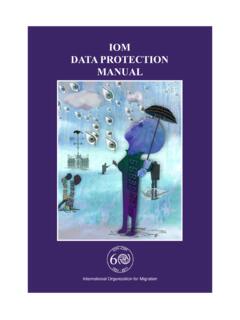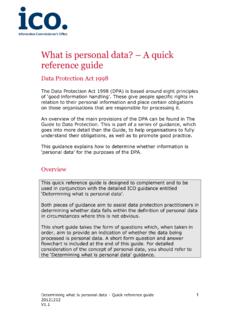Transcription of Flowcharts and Checklists on Data Protection
1 Flowcharts and Checklistson data Protection European Union 2020 Reproduction is authorised provided the source is ISBN 978-92-9242-461-9 doi: QT-02-20-505-EN-CPRINT ISBN 978-92-9242-462-6 doi: QT-02-20-505-EN-NTable of ContentsFlowchart: are you a processor, controller or joint controller? .. 3 Checklist 1: What are the duties of the controller? .. 4 Checklist 2: What are the duties of the processor? .. 7 Checklist 3: What is required in a processing agreement?.. 8 Useful hints and questions on data Protection .
2 10 data transfers and Brexit .. 13 Powers of the EDPS under Regulation (EU) 2018/1725(EU institutions data Protection Regulation - EUDPR) .. 14 Administrative fines and sanctions under EUDPR .. 16 EUDPR - Infringements .. 17 Are you a processor, controller or joint controller?Thisw chart is for situations where the allocation of the processor and controller roles has not been established in a legal act. Flowchart for EUIs. You are involved in a processing operation with one or more third parties: are you a processor, a controller, or a joint controller?
3 Do you determine certain purposes and essential means of the processing operation, based on a specic legal competence?YesNoDo you determine certain purposes and essential means of the processing operation, based on an implicit competence?YesDo you determine certain purposes and essential means of the processing operationin practice?NoYesWhat is the relationship between you (A) and the other party (B)?You are a processorYou jointly determine the purposes and essential means for the processing operation with jointly determine some essential means and purposes with B, while others are determined and B separately determine purposes and essential means for the processing you determine the purposes and essential means of the processing +BABABAYou and B are joint are joint controller with B for the jointly determined parts of the processing are a controller, B is your is controller for its own means and purposes.
4 But processor for are a : The aim of this owchart is to clarify the initial qualication as controller or processor, rather than setting out what happens when a processor exceeds its mandate/role by becoming involved in determining essential means of the !3 Processing of personal data needs to adhere to the following principles: the processing operation should be lawful, fair and transparent (lawfulness, fairness, transparency); the processing operation should be bound to specific purposes (purpose limitation); the personal data processed should be adequate, relevant and limited to what is necessary ( data minimisation).
5 See the EDPS guide Accountability on the ground, part II, pages 11-15 for guiding questions on these data Protection the EDPS Accountability on the ground for guidance on records, DPIA s, prior consultation and controller is responsible for compliance with these principles and should be able to demonstrate this compliance (principle of accountability). To achieve this, controllers in practice need to, in particular: document their processing operations with records; (Note: the EDPS strongly recommends keeping these records in a central, publicly accessible register); carry out a data Protection impact assessment (DPIA), prior to operations which carry a high risk to the rights and freedoms of data subjects; under certain circumstances, consult the EDPS prior to such high-risk processing operations.
6 When designing processing operations, keep in mind the principles of privacy by design and privacy by default; take adequate security measures in order to protect personal data ; in case of a personal data breach, notify the EDPS as well as, under certain circumstances, the data subjects involved; conclude agreements/contracts with processors (only those providing sufficient guarantees); conclude agreements with other controllers in cases of joint controllership; transfer personal data within the European Institution, agency or body (EUI), to other EUIs, to countries outside of the EU or international organisations only when the conditions of the Regulation (EU) 2018/1725 are complied with; cooperate with the EDPS.
7 The personal data should be accurate (accuracy); the personal data should be kept no longer than necessary (storage limitation); the personal data need to be remain well secured and confidential (integrity and confidentiality).Checklist 1:What are the duties of the controller?Finally, the controller need to provide clear and accessible information to data subjects about the processing, respect data subject s rights and ensure their availability in the EDPS guidelines on transparency and other rights and your processing operations Article 4 of EUDPR lists the data Protection principles.
8 Additional Articles in this Regulation spell them out in more detail:Create a systematic description of the processing. Start from the information you already have in your notification or record and add the following points: data flow diagram of the process (flowchart): what do we collect from where/whom, what do we do with it, where do we keep it, to whom do we give it? detailed description of the purpose(s) of the processing: explain the process step-by-step, distinguishing between purposes where necessary; description of its interactions with other processes - does this process rely on personal data being fed in from other systems?
9 Are personal data from this process re-used in other processes? description of the supporting infrastructure: filing systems, ICT existing documentation of the process or its development to generate this documentation. Re-read this existing documentation through the lens of how will this affect the people whose data we process? and adapt and expand where necessary. Go through your data flow diagram and for each step, ask yourself how this could affect the persons concerned against the background of the data Protection table below maps the targets to some generic processing steps, indicating the most relevant targets for each.
10 These are the minimum aspects to is to be ensured as the first stage and at each processing principleFairnessTransparencyPurpose limitationData minimisationAccuracyStorage limitationSecurityArticlesArticle 4(1), 17 to 25 Articles 4(1)(a), 14 to 16, 25 Articles 4(1)(b), 6, 13, 38 Articles 4(1)(c), 12, 13, 37, 38 Articles 4(1)(d), 18 Articles 4(1)(e), 13 Articles 4(1)(f ), 33, 36, 37, 39 Recitals20, 26, 34, 35, 37-4120, 35, 3625203820, 3353, 54, 585 See the EDPS Accountability on the ground guidance, part II, pages 7, 9-11 for mapping data Protection principles to generic processing datasetsOrganisation/structuresRetrieval /consultation/useEditing/alterationDiscl osure/TransferRestrictionStorageErasure/ destructionXXOXEXRXXXOXXXRXXXXXOXXXXXXXO XXXOOXXXXOOXXXXXXXXXXXXF airnessTransparency PurposeLimitationDataminimisationStorage limitationSecurity6 Checklist 2.











